Impact of Hydropower on Air Pollution and Economic Growth in China
Abstract
1. Introduction
2. Literature Review
3. Methodology and Data
3.1. Spatial Correlation Analysis
3.2. Model Construction
3.2.1. Economic Growth Model
3.2.2. Haze Pollution Model
3.2.3. GWR Model Construction
3.3. Direct and Indirect Effects
3.4. Variable Selection and Data Sources
3.4.1. Variable Selection of Economic Growth Model
3.4.2. Variable Selection of Haze Pollution Model
3.4.3. Data Sources
3.5. Spatial Weight Matrix Construction
3.6. The Applicability Test of the Spatial Panel Model
4. Empirical Results and Analysis
4.1. Spatial Autocorrelation Test Result
4.2. The Impact of Hydropower on Regional Economic Growth
4.3. The Impact of Hydropower on Haze Pollution
4.4. Robustness Analysis
4.5. Analysis of Heterogeneity
5. Conclusions and Policy Implications
5.1. Conclusions
- (1)
- Hydropower generation, haze pollution and economic growth in China’s provinces all have significant positive spatial auto-correlation, which is manifested as high-high type and low-low type clustering. Both the positive spatial auto-correlation of haze pollution and economic growth are manifested as spatial “spillover effects” and temporal “superimposed effects”. The difference is that the spatial “spillover effect” of haze pollution is greater than the temporal “superimposition effect”, while the temporal “superimposition effect” of economic growth is greater than the spatial “spillover effect”. When considering both the time and space dimensions, the spatial and temporal lag coefficient of haze pollution is significantly negative, while the spatial and temporal lag coefficient of economic growth is significantly positive;
- (2)
- Hydropower can significantly promote economic growth. Moreover, the spatial spillover effect of hydropower on economic growth is greater than the local effect, indicating that hydropower has a greater neighboring effect in promoting economic growth in the eastern region through the “West-to-East Power Transmission”. The long-term impact of hydropower on economic growth is greater than the short-term impact;
- (3)
- Hydropower can significantly inhibit haze pollution. Moreover, the spatial spillover effect of hydropower on haze pollution is greater than the local effect. However, as a transitional stage in the short term, hydropower has not been able to effectively inhibit the haze pollution in the region. In the long term, hydropower can effectively inhibit local and neighboring haze pollution;
- (4)
- The promotion effect of hydropower on economic growth in the western region is less than that in the eastern region, which further aggravates the economic development gap between the eastern and western regions. The inhibition effect of hydropower on haze pollution in the western region is greater than that in the eastern region.
5.2. Policy Implications
- (1)
- The regional distribution of China’s hydropower resources is uneven. The western region, especially the southwest region, is rich in hydropower resources and has potential for development. Therefore, the construction of hydropower infrastructure should be strengthened, and the energy structure of the eastern region should be improved with the help of the “West-to-East power transmission” project to reduce haze pollution. In addition, scientific planning for hydropower construction in the western region can effectively transform the resource advantages of the western region into economic advantages and boost the economic development of the western region;
- (2)
- From a regional perspective, the contribution of hydropower resources to the economic growth of the western region of the main production area is much smaller than that of the eastern region of the importing area, which further exacerbates the economic development gap between the west and the east. The western region should use the “West-to-East Power Transmission” and other large-scale development projects in the western region to transform energy advantages into economic advantages, attract the transfer of eastern and international industries with abundant and cheap clean energy, vigorously develop advantageous characteristic industries, and promote economic development in the western region;
- (3)
- Regional economic growth has a significant spatial spillover effect, which helps to alleviate regional uneven development. When formulating economic development policies at the national level, we should vigorously guide inter-regional cooperation, especially the cooperation between the east and the west, optimize the cross-regional allocation of resources, and give full play to the spatial spillover effects of economic growth;
- (4)
- China’s provincial haze pollution has significant spatial spillover effects and temporal superposition effects, which requires haze governance to adopt “joint prevention and control” policy and strengthen long-term regional cooperation. Any unilateral governance activities will be difficult to achieve more significant results due to the spatial spillover effect of haze pollution, and the lax governance in any period will aggravate the haze pollution level in the next period. This requires that haze management adopt a “joint prevention and control” policy and strengthen long-term cooperation among different regions.
Author Contributions
Funding
Institutional Review Board Statement
Informed Consent Statement
Data Availability Statement
Acknowledgments
Conflicts of Interest
References
- Xu, B.; Chen, Y.F.; Shen, X.B. Clean energy development, carbon dioxide emission reduction and regional economic growth. Econ. Res. J. 2019, 54, 188–202. [Google Scholar]
- Shao, S.; Zhang, X.; Zhao, X.R. Empirical decomposition and peaking pathway of carbon dioxide emissions of China’s manufacturing sector-generalized divisia index method and dynamic scenario analysis. China Ind. Econ. 2017, 3, 44–63. [Google Scholar]
- Chen, S.Y.; Chen, D.K. Air pollution, government regulations and high-quality economic development. Econ. Res. J. 2018, 53, 20–34. [Google Scholar]
- Yang, S.Y.; Wang, F.; Liu, N. Assessment of the air pollution prevention and control action plan in China: A difference-in-difference analysis. China Popul. Resour. Environ. 2020, 30, 110–117. [Google Scholar]
- Anser, M.K.; Hanif, I.; Vo, X.V.; Alharthi, M. The long-run and short-run influence of environmental pollution, energy consumption, and economic activities on health quality in emerging countries. Environ. Sci. Pollut. Res. 2020, 27, 32518–32532. [Google Scholar] [CrossRef]
- Hu, F.X.; He, G.C. Energy-saving and emission reduction benefit analysis on west-to-east transmission project of China southern power grid. Autom. Electr. Power Syst. 2014, 38, 20–24. [Google Scholar]
- Yu, Q.Q. Analysis on the competitiveness of trans-provincial and trans-regional hydropower transmission in power market. Water Power 2020, 46, 95–98. [Google Scholar]
- Ma, L.M.; Zhang, X. The spatial effect of China’s haze pollution and the impact from economic change and energy structure. China Ind. Econ. 2014, 4, 19–31. [Google Scholar]
- Li, L.; Hong, X.; Wang, J. Evaluating the impact of clean energy consumption and factor allocation on China’s air pollution: A spatial econometric approach. Energy 2020, 195, 116842. [Google Scholar] [CrossRef]
- Wei, W.X.; Zhao, Y.R. Analysis of feed-in tariff on atmospheric environmental benefits. China Popul. Resour. Environ. 2017, 27, 209–216. [Google Scholar]
- Xu, X.L. Impacts of the clean energy subsidy reform on industry development and environment pollution: An analysis based on a dynamic CGE model. J. Shanghai Univ. Financ. Econ. 2018, 20, 44–57. [Google Scholar]
- Xie, Y.; Wu, D.; Zhu, S. Can new energy vehicles subsidy curb the urban air pollution? empirical evidence from pilot cities in China. Sci. Total Environ. 2021, 754, 142232. [Google Scholar] [CrossRef]
- Dogan, E.; Seker, F. Determinants of CO2 emissions in the European Union: The role of renewable and non-renewable energy. Renew. Energy 2016, 94, 429–439. [Google Scholar] [CrossRef]
- Zoundi, Z. CO2 emissions, renewable energy and the Environmental Kuznets Curve, a panel cointegration approach. Renew. Sustain. Energy Rev. 2017, 72, 1067–1075. [Google Scholar] [CrossRef]
- Razmjoo, A.; Kaigutha, L.G.; Rad, M.A.V.; Marzband, M.; Davarpanah, A.; Denai, M. A technical analysis investigating energy sustainability utilizing reliable renewable energy sources to reduce emissions in a high potential area. Renew. Energy 2021, 164, 46–57. [Google Scholar] [CrossRef]
- Zhang, X.D.; Liu, X.Y. Study on carbon taxation and developing renewable energy—Growth and welfare effects analyses based on OLG-CGE model. China Ind. Econ. 2015, 3, 18–30. [Google Scholar]
- Inglesi-Lotz, R. The impact of renewable energy consumption to economic growth: A panel data application. Energy Econ. 2016, 53, 58–63. [Google Scholar] [CrossRef]
- Bhattacharya, M.; Paramati, S.R.; Ozturk, I.; Bhattacharya, S. The effect of renewable energy consumption on economic growth: Evidence from top 38 countries. Appl. Energy 2016, 162, 733–741. [Google Scholar] [CrossRef]
- Lin, M.S. The clean energy consumption, environment governance and the sustainable economic growth in China. J. Quant. Tech. Econ. 2017, 34, 3–21. [Google Scholar]
- Pilatowska, M.; Geise, A. Impact of clean energy on CO2 emissions and economic growth within the phases of renewables diffusion in selected european countries. Energies 2021, 14, 812. [Google Scholar] [CrossRef]
- Kahia, M.; Aissa, M.B.; Lanouar, C. Renewable and non-renewable energy use-economic growth nexus: The case of MENA Net oil importing countries. Renew. Sustain. Energy Rev. 2017, 71, 127–140. [Google Scholar] [CrossRef]
- Destek, M.A.; Aslan, A. Renewable and non-renewable energy consumption and economic growth in emerging economies: Evidence from bootstrap panel causality. Renew. Energy 2017, 111, 757–763. [Google Scholar] [CrossRef]
- Keček, D.; Mikulić, D.; Lovrinčević, Ž. Deployment of renewable energy: Economic effects on the Croatian economy. Energy Policy 2019, 126, 402–410. [Google Scholar] [CrossRef]
- Lin, B.Q.; Sun, C.W. How can China achieve its carbon emission reduction target while sustaining economic growth? Soc. Sci. China 2011, 1, 64–76. [Google Scholar]
- Dietz, T.; Rosa, E.A. Effects of population and affluence on CO2 emissions. Proc. Natl. Acad. Sci. USA 1997, 94, 175–179. [Google Scholar] [CrossRef]
- Cheng, Z.H.; Liu, J.; Li, L.S. Research on the Effects of Industrial Structure Adjustment and Technical Progress on Haze Reduction. China Soft Sci. 2019, 1, 146–154. [Google Scholar]
- Gong, M.Q.; Liu, H.Y. The influence of two-way FDI coordinated development and industrial structure evolution on environmental pollution in China. J. Int. Trade 2020, 2, 110–124. [Google Scholar]
- Shao, S.; Li, X.; Cao, J.H.; Yang, L.L. China’s economic policy choices for governing smog pollution based on spatial spillover effects. Econ. Res. J. 2016, 51, 73–88. [Google Scholar]
- Brunsdon, C.; Fotheringham, A.S.; Charlton, M. Geographically weighted regression: A method for exploring spatial nonstationary. Geogr. Anal. 1996, 28, 281–298. [Google Scholar] [CrossRef]
- Xu, B.; Lin, B. Investigating spatial variability of CO2 emissions in heavy industry: Evidence from a geographically weighted regression model. Energy Policy 2020, 149, 112011. [Google Scholar] [CrossRef]
- LeSage, J.P.; Pace, R.K. Introduction to Spatial Econometrics; CRC Press: Boca Raton, FL, USA, 2010; pp. 24–53. [Google Scholar]
- Zafar, M.W.; Shahbaz, M.; Hou, F.; Sinha, A. From nonrenewable to renewable energy and its impact on economic growth: The role of research & development expenditures in Asia-Pacific Economic Cooperation countries. J. Clean. Prod. 2019, 212, 1166–1178. [Google Scholar]
- Saidi, K.; Omri, A. The impact of renewable energy on carbon emissions and economic growth in 15 major renewable energy-consuming countries. Environ. Res. 2020, 186, 109567. [Google Scholar] [CrossRef] [PubMed]
- Li, M.; Long, K. Direct or spillover effect: The impact of pure technical and scale efficiencies of water use on water scarcity in china. Int. J. Environ. Res. Public Health 2019, 16, 3401. [Google Scholar] [CrossRef]
- van Donkelaar, A.; Martin, R.V.; Brauer, M.; Hsu, N.C.; Kahn, R.A.; Levy, R.C.; Lyapustin, A.; Sayer, A.M.; Winker, D.M. Global estimates of fine particulate matter using a combined geophysical-statistical method with information from satellites. Environ. Sci. Technol. 2016, 50, 3762–3772. [Google Scholar] [CrossRef] [PubMed]
- Liu, K.; Lin, B. Research on influencing factors of environmental pollution in China: A spatial econometric analysis. J. Clean. Prod. 2019, 206, 356–364. [Google Scholar] [CrossRef]
- Li, K.; Fang, L.; He, L. How population and energy price affect China’s environmental pollution? Energy Policy 2019, 129, 386–396. [Google Scholar] [CrossRef]
- Yu, Y.Z.; Zhang, S.H. Urban housing prices, purchase restriction policy and technological innovation. China Ind. Econ. 2017, 6, 98–116. [Google Scholar]
- Elhorst, J.P. Matlab software for spatial panels. Int. Reg. Sci. Rev. 2014, 37, 389–405. [Google Scholar] [CrossRef]
- Lee, L.; Yu, J. A spatial dynamic panel data model with both time and individual fixed effects. Econom. Theory 2010, 26, 564–597. [Google Scholar] [CrossRef]
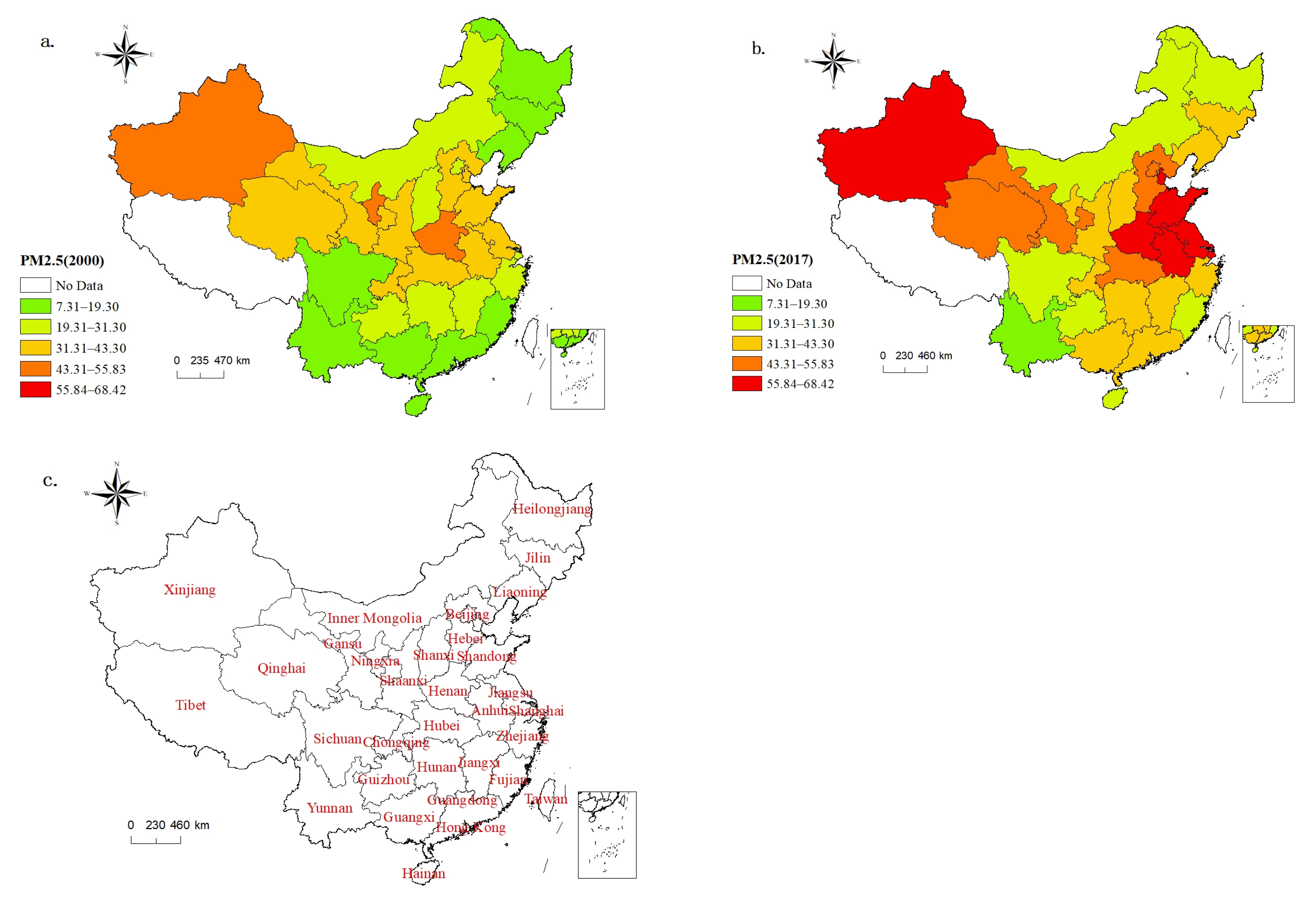
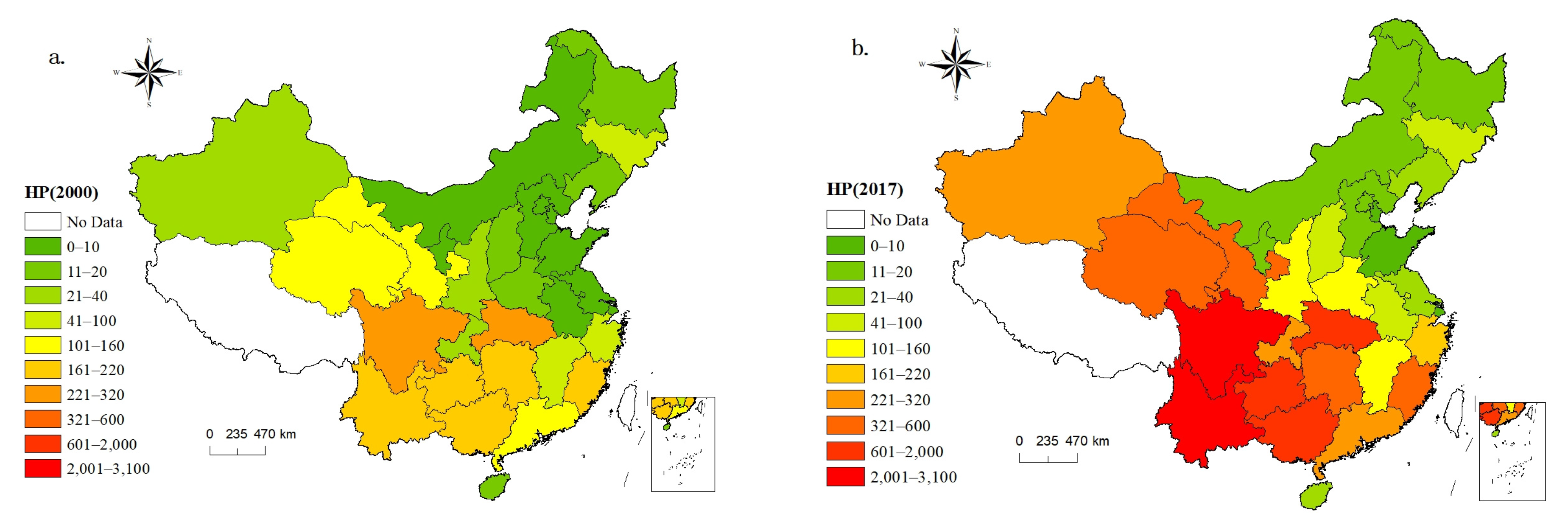
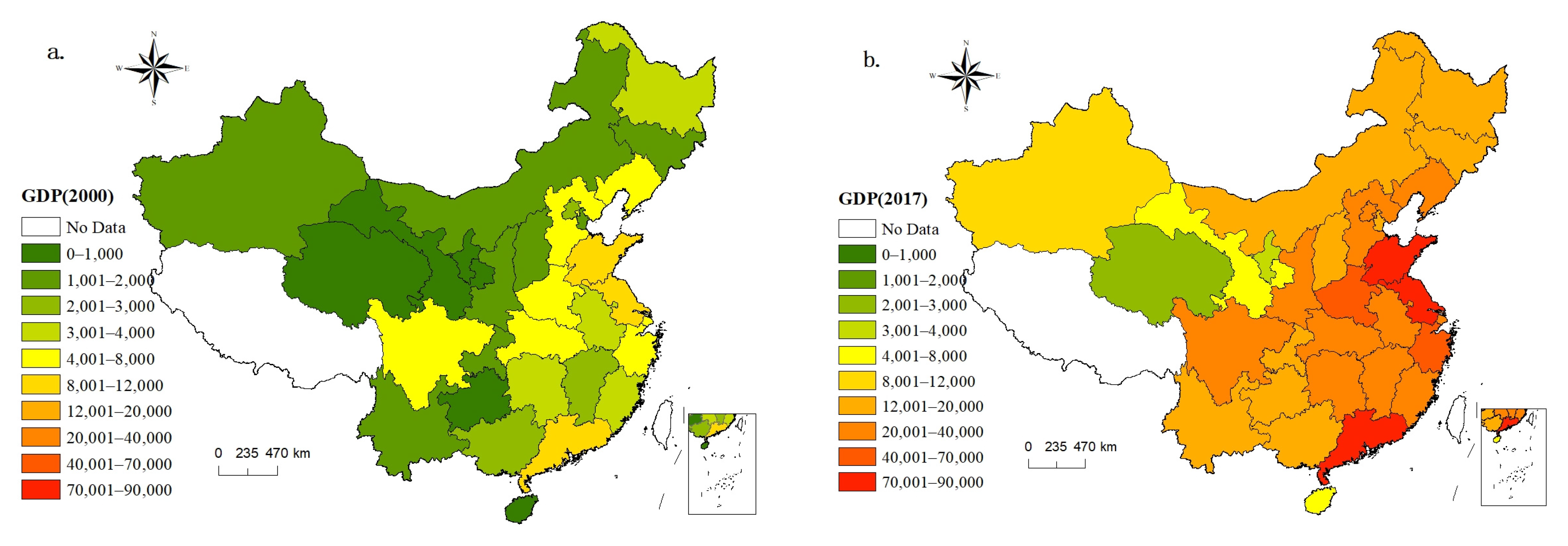
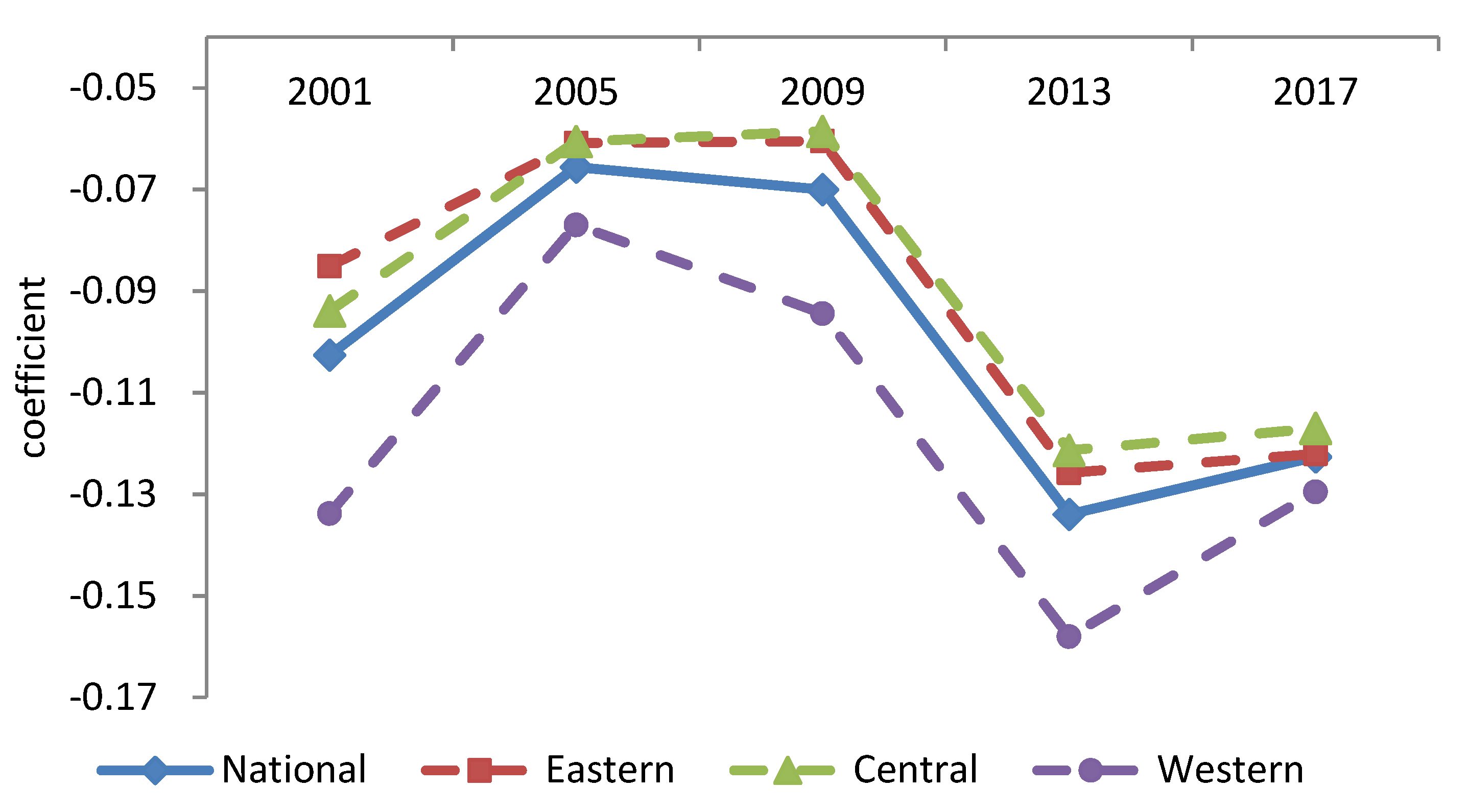
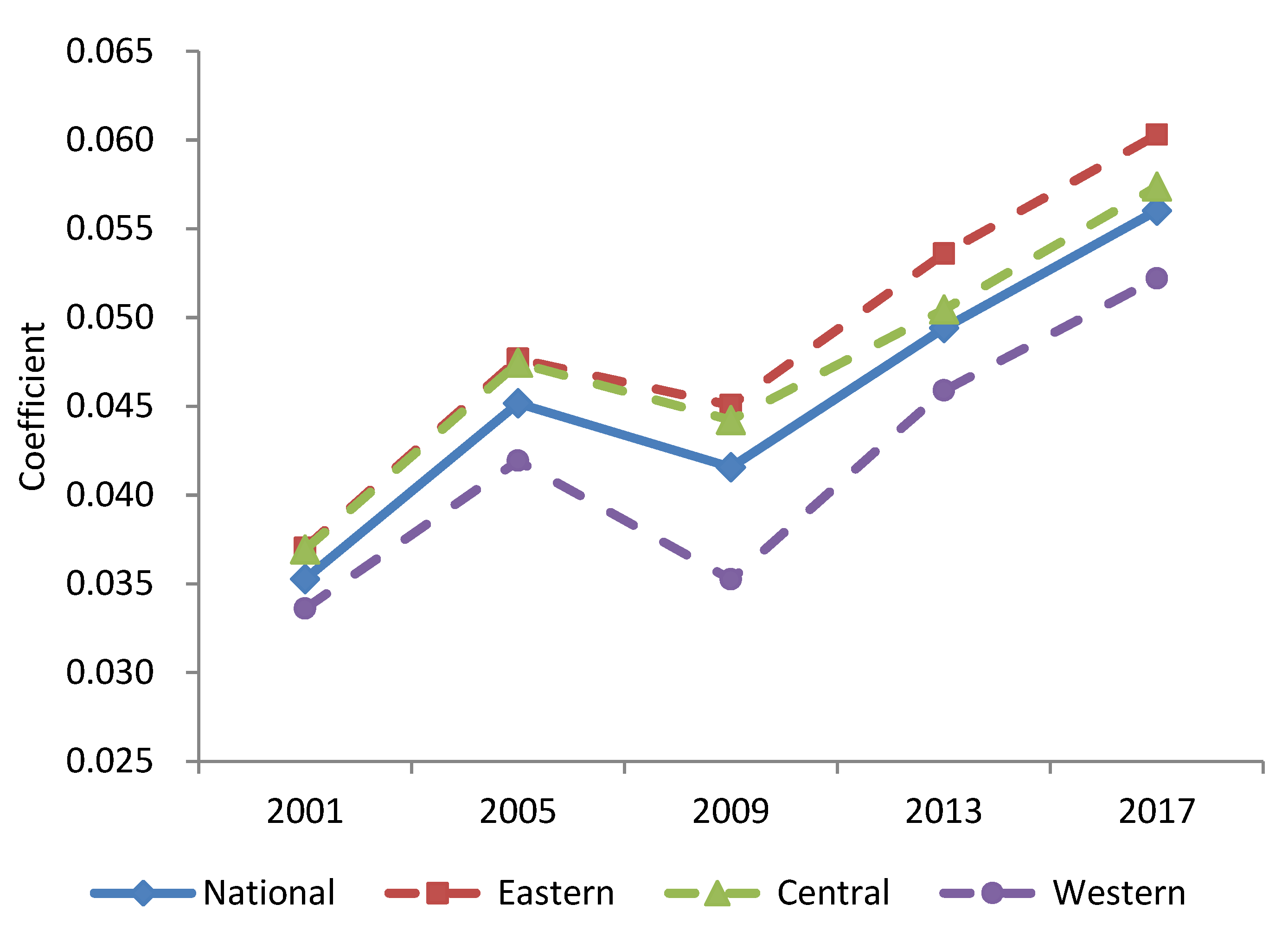
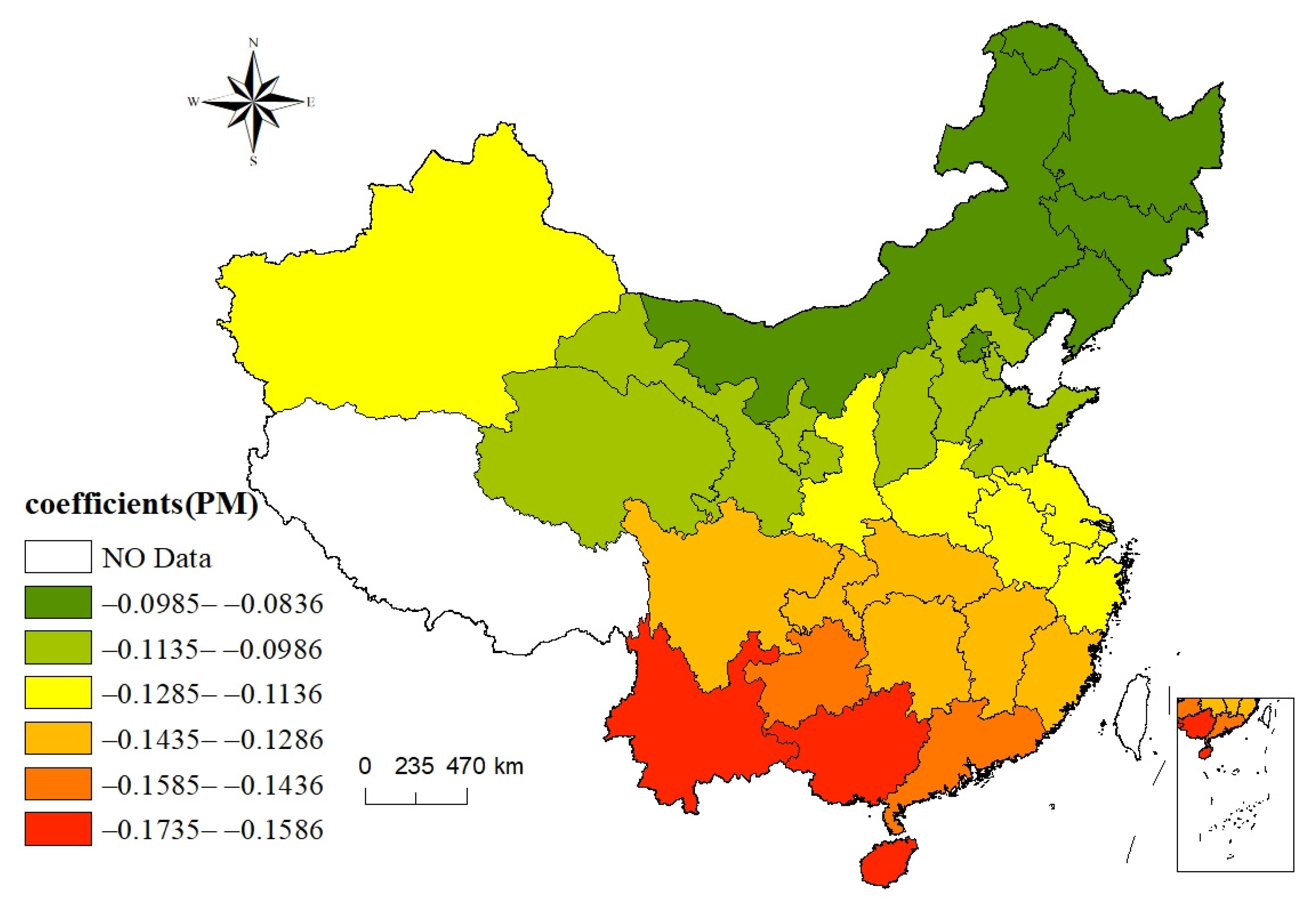
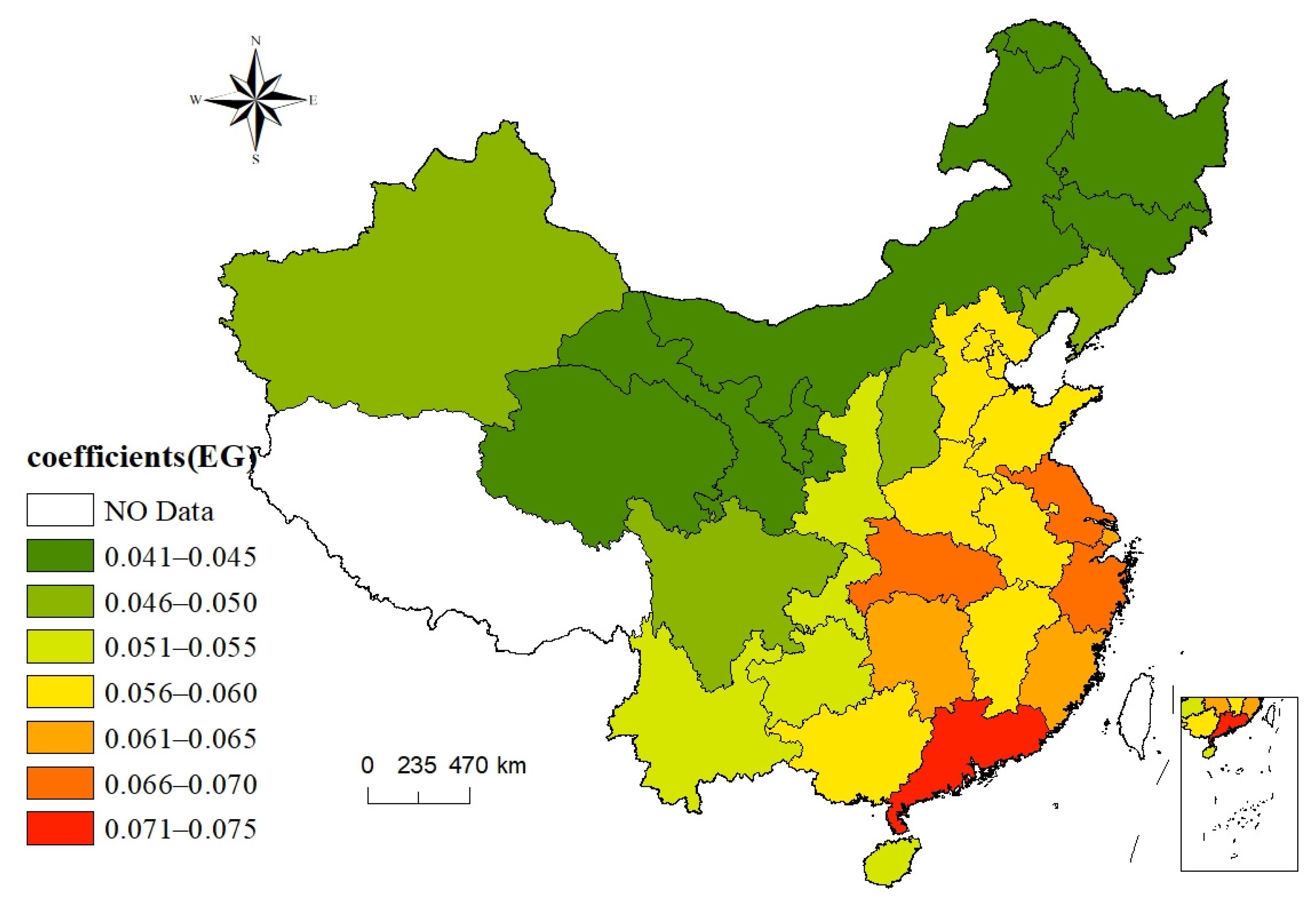
| Variable | Symbol | Definition | Observations | Mean | S. D. | Min | Max | Source |
|---|---|---|---|---|---|---|---|---|
| Economic growth | lnEG | Real GDP per capita (ten thousand yuan) | 540 | 9.769 | 0.750 | 7.887 | 11.718 | China Statistical Yearbook |
| Haze pollution | lnPM | Haze concentration (μg/m3) | 540 | 3.571 | 0.463 | 1.991 | 4.437 | See footnote 1 |
| Hydropower | lnHP | Hydropower generation (100 million kWh) | 540 | 3.943 | 1.972 | 0 | 8.020 | Almanac of China’s Water Power |
| Capital stock | lnCS | Perpetual inventory calculation method (100 million yuan) | 540 | 9.831 | 0.960 | 7.359 | 11.93 | China Statistical Yearbook |
| Labor input | lnEP | Sum of employed persons (10 thousand people) | 540 | 7.551 | 0.820 | 5.619 | 8.820 | China Statistical Yearbook |
| Technological innovation | lnRD | Internal expenditure of R&D expenditure (100 million yuan) | 540 | 4.372 | 1.635 | −0.186 | 7.759 | China Statistical Yearbook on Science and Technology |
| Urbanization | lnUR | Proportion of urban population in total population (%) | 540 | 3.855 | 0.298 | 3.144 | 4.495 | China Statistical Yearbook |
| Population density | lnPD | Number of people per unit area (person/square kilometers) | 540 | 5.418 | 1.262 | 2.003 | 8.249 | China Statistical Yearbook |
| Industrial structure | IS | Calculated according to Petty–Clark theorem | 540 | 2.289 | 0.130 | 2.028 | 2.801 | China Statistical Yearbook |
| Water scarcity | WS | Ratio of water consumption to renewable water resources | 540 | 0.849 | 1.510 | 0.031 | 9.187 | China Statistical Yearbook on Environment |
| Test Statistics | Model (4) | Model (7) | ||
|---|---|---|---|---|
| Chi-Square Value | p Value | Chi-Square Value | p Value | |
| LM-lag | 28.716 | 0.000 | 29.917 | 0.000 |
| R-LM-lag | 13.192 | 0.001 | 11.939 | 0.001 |
| LM-error | 547.262 | 0.000 | 1059.839 | 0.000 |
| R-LM-error | 548.712 | 0.000 | 1049.014 | 0.000 |
| LR test for SLM | 19.87 | 0.003 | 34.06 | 0.000 |
| Wald test for SLM | 21.50 | 0.002 | 33.92 | 0.000 |
| LR test for SEM | 16.89 | 0.010 | 40.15 | 0.000 |
| Wald test for SEM | 18.19 | 0.006 | 38.64 | 0.000 |
| Hausman test | 24.01 | 0.008 | 48.01 | 0.000 |
| Year | Economic Dimension Spatial Weight Matrix (W3) | Geographical Dimension Spatial Weight Matrix (W1) | ||||||||||
|---|---|---|---|---|---|---|---|---|---|---|---|---|
| Hydropower (HP) | Haze Pollution (lnPM) | Economic Growth (lnPGDP) | Hydropower (HP) | Haze Pollution (lnPM) | Economic Growth (lnPGDP) | |||||||
| Moran’s I | Z | Moran’s I | Z | Moran’s I | Z | Moran’s I | Z | Moran’s I | Z | Moran’s I | Z | |
| 2000 | 0.100 *** | 3.931 | 0.089 *** | 3.578 | 0.091 *** | 3.664 | 0.380 *** | 3.421 | 0.452 *** | 3.949 | 0.457 *** | 4.065 |
| 2001 | 0.102 *** | 4.008 | 0.095 *** | 3.735 | 0.092 *** | 3.681 | 0.344 *** | 3.162 | 0.498 *** | 4.304 | 0.456 *** | 4.059 |
| 2002 | 0.090 *** | 3.664 | 0.094 *** | 3.727 | 0.092 *** | 3.696 | 0.366 *** | 3.372 | 0.468 *** | 4.093 | 0.457 *** | 4.067 |
| 2003 | 0.086 *** | 3.564 | 0.112 *** | 4.253 | 0.093 *** | 3.718 | 0.307 *** | 2.903 | 0.470 *** | 4.140 | 0.460 *** | 4.085 |
| 2004 | 0.031 ** | 1.982 | 0.071 *** | 3.074 | 0.095 *** | 3.769 | 0.163 ** | 1.835 | 0.420 *** | 3.720 | 0.464 *** | 4.107 |
| 2005 | 0.039 ** | 2.206 | 0.070 *** | 3.027 | 0.096 *** | 3.798 | 0.148 ** | 1.667 | 0.423 *** | 3.732 | 0.466 *** | 4.114 |
| 2006 | 0.053 *** | 2.620 | 0.094 *** | 3.731 | 0.097 *** | 3.819 | 0.187 ** | 1.962 | 0.453 *** | 3.979 | 0.469 *** | 4.127 |
| 2007 | 0.055 *** | 2.683 | 0.082 *** | 3.397 | 0.096 *** | 3.805 | 0.219 ** | 2.257 | 0.444 *** | 3.902 | 0.467 *** | 4.109 |
| 2008 | 0.065 *** | 2.983 | 0.070 *** | 3.031 | 0.097 *** | 3.817 | 0.244 *** | 2.483 | 0.406 *** | 3.592 | 0.463 *** | 4.073 |
| 2009 | 0.063 *** | 2.901 | 0.065 *** | 2.907 | 0.096 *** | 3.806 | 0.264 *** | 2.647 | 0.365 *** | 3.271 | 0.459 *** | 4.029 |
| 2010 | 0.067 *** | 3.026 | 0.074 *** | 3.149 | 0.096 *** | 3.799 | 0.272 *** | 2.660 | 0.396 *** | 3.525 | 0.458 *** | 4.017 |
| 2011 | 0.066 *** | 3.008 | 0.085 *** | 3.472 | 0.094 *** | 3.718 | 0.295 *** | 2.897 | 0.469 *** | 4.088 | 0.446 *** | 3.919 |
| 2012 | 0.076 *** | 3.287 | 0.071 *** | 3.079 | 0.092 *** | 3.684 | 0.338 *** | 3.214 | 0.394 *** | 3.515 | 0.438 *** | 3.847 |
| 2013 | 0.063 *** | 2.933 | 0.101 *** | 3.921 | 0.091 *** | 3.641 | 0.321 *** | 3.228 | 0.472 *** | 4.104 | 0.430 *** | 3.782 |
| 2014 | 0.062 *** | 2.908 | 0.081 *** | 3.353 | 0.089 *** | 3.593 | 0.338 *** | 3.415 | 0.388 *** | 3.471 | 0.423 *** | 3.719 |
| 2015 | 0.066 *** | 3.058 | 0.103 *** | 4.002 | 0.088 *** | 3.553 | 0.360 *** | 3.643 | 0.434 *** | 3.829 | 0.418 *** | 3.682 |
| 2016 | 0.061 *** | 2.909 | 0.111 *** | 4.214 | 0.087 *** | 3.529 | 0.316 *** | 3.263 | 0.474 *** | 4.137 | 0.419 *** | 3.688 |
| 2017 | 0.051 *** | 2.609 | 0.093 *** | 3.701 | 0.087 *** | 3.541 | 0.314 *** | 3.288 | 0.451 *** | 3.944 | 0.421 *** | 3.706 |
| Variable | Economic Dimension Spatial Weight Matrix (W3) | Geographical Dimension Spatial Weight Matrix (W1) | ||||
|---|---|---|---|---|---|---|
| (1) SDM | (2) SDM | (3) DSDM | (4) SDM | (5) SDM | (6) DSDM | |
| W*lnEG | 0.2535 *** (4.757) | 0.2441 *** (4.677) | 0.8016 *** (5.007) | 0.3148 *** (5.227) | 0.3116 *** (5.108) | 0.3964 ** (2.460) |
| lnEGt−1 | 1.0035 *** (82.151) | 0.9666 *** (74.948) | ||||
| W*lnEGt−1 | 0.5248 *** (2.755) | 0.1395 ** (2.235) | ||||
| lnHP | 0.0323 *** (4.171) | 0.0075 *** (3.330) | 0.0369 *** (4.691) | 0.0094 *** (4.031) | ||
| lnCS | 0.3416 *** (16.343) | 0.3564 *** (16.924) | 0.0137 ** (2.255) | 0.3739 *** (17.541) | 0.3905 *** (18.284) | 0.0179 ** (2.438) |
| lnEP | −0.0015 (−0.459) | 0.0012 (0.355) | 0.0002 (0.174) | 0.0063 ** (2.171) | −0.0034 (−1.159) | −0.0001 (−0.128) |
| lnRD | 0.0448 *** (3.198) | 0.0348 ** (2.496) | 0.0028 (0.683) | 0.0429 *** (3.084) | 0.0334 ** (2.393) | −0.0057 (−1.376) |
| lnUR | 0.2800 *** (6.762) | 0.2267 *** (5.186) | −0.0088 (−0.637) | 0.2356 *** (5.428) | 0.1952 *** (4.414) | 0.0254 * (1.797) |
| WS | −0.0077 * (−1.896) | −0.0041 * (−1.844) | −0.0036 ** (−2.330) | −0.0020 ** (−2.412) | −0.0019 ** (−2.387) | −0.0040 ** (−2.535) |
| W*lnHP | 0.0391 * (1.857) | 0.0303 ** (2.324) | 0.0113 * (1.862) | 0.0151 *** (3.549) | ||
| W*lnCS | −0.5598 *** (−3.869) | −0.5979 *** (−3.960) | −0.3247 *** (−6.239) | −0.1586 *** (−4.023) | −0.1565 *** (−3.852) | −0.0510 *** (−3.109) |
| W*lnEP | 0.0539 ** (2.268) | 0.0480 ** (2.052) | 0.0223 *** (3.368) | 0.0024 (0.372) | 0.0038 (0.592) | 0.0019 (1.009) |
| W*lnRD | −0.1835 ** (−2.165) | −0.1366 (−1.623) | −0.1032 *** (−3.897) | 0.0378 (1.502) | 0.0524 ** (2.088) | 0.0071 (0.934) |
| W*lnUR | 0.5323 * (1.832) | 0.4049 (1.329) | −0.0179 (−0.182) | −0.0657 (−0.866) | −0.1539 ** (−1.967) | −0.0294 (−1.138) |
| W*WS | −0.0031 (0.103) | −0.0040 (−0.135) | 0.0185 (1.055) | −0.0259 ** (−2.444) | −0.0191 (−1.282) | −0.0095 *** (−2.731) |
| R2 | 0.8198 | 0.8234 | 0.9856 | 0.9805 | 0.9806 | 0.9985 |
| Log-Likelihood | 851.3698 | 860.7785 | −2.303 × 105 | −2.303 × 105 | −2.303 × 105 | −835.4572 |
| Observations | 540 | 540 | 510 | 540 | 540 | 510 |
| Variable | Short-Term Impact | Long-Term Impact | ||||
|---|---|---|---|---|---|---|
| Direct Effect | Indirect Effect | Total Effect | Direct Effect | Indirect Effect | Total Effect | |
| Economic dimension spatial weight matrix (W3) | ||||||
| lnHP | 0.0147 *** (2.717) | 0.0273 *** (2.807) | 0.0420 *** (3.004) | 0.1123 *** (2.811) | 0.1824 *** (2.809) | 0.2947 *** (2.919) |
| Geographical dimension spatial weight matrix (W1) | ||||||
| lnHP | 0.0100 *** (4.504) | 0.0178 *** (4.046) | 0.0278 *** (5.766) | 0.0217 ** (2.316) | 0.0471 *** (3.734) | 0.0688 ** (2.370) |
| Variable | Economic Dimension Spatial Weight Matrix (W3) | Geographical Dimension Spatial Weight Matrix (W1) | ||||
|---|---|---|---|---|---|---|
| (1) SDM | (2) SDM | (3) DSDM | (4) SDM | (5) SDM | (6) DSDM | |
| W*lnPM | 0.5045 *** (4.857) | 0.5055 *** (4.878) | 0.6389 *** (7.992) | 0.6845 *** (18.305) | 0.6806 *** (18.064) | 0.6740 *** (17.221) |
| lnPMt−1 | 0.4045 *** (9.903) | 0.3105 *** (7.179) | ||||
| W*lnPMt−1 | −0.6500 ** (−2.359) | −0.1715 ** (−2.446) | ||||
| lnHP | −0.0100 * (−1.661) | −0.0044 * (−1.711) | −0.0057 ** (−2.314) | −0.0047 * (−1.801) | ||
| lnEG | −1.1150 *** (−3.694) | −0.9763 *** (−3.195) | −0.3498 (−1.289) | −0.0881 (−0.352) | −0.0379 (−0.150) | −0.0600 (−0.248) |
| (lnEG)2 | 0.0513 *** (3.572) | 0.0434 *** (2.970) | 0.0131 (1.003) | 0.0040 (0.337) | 0.0008 (0.064) | 0.0021 (0.181) |
| lnPD | −0.5272 *** (−3.452) | −0.5136 *** (−3.337) | −0.3765 *** (−2.809) | −0.1233 (−0.887) | −0.1242 (−0.889) | −0.2241 * (−1.674) |
| lnRD | −0.0713 ** (−2.543) | −0.0627 ** (−2.197) | −0.0287 ** (−2.170) | −0.0701 *** (−3.278) | −0.0704 *** (−3.261) | −0.0432 ** (−2.179) |
| IS | 0.0339 (0.201) | 0.0576 (0.339) | 0.0077 (0.052) | −0.2530 ** (−2.019) | −0.2578 ** (−2.055) | −0.0755 (−0.646) |
| WS | −0.0010 (−0.103) | 0.0006 (0.062) | −0.0090 (−0.964) | 0.0076 (0.949) | 0.0079 (0.990) | 0.0009 (0.115) |
| W*lnHP | −0.2146 ** (−2.425) | −0.1542 ** (−2.053) | −0.0410 * (−1.797) | −0.0439 ** (−2.091) | ||
| W*lnEG | −6.3202 *** (−3.962) | −6.5048 *** (−4.007) | −3.7250 ** (−2.557) | −2.2495 *** (−5.553) | −2.2356 *** (−5.427) | −0.9907 ** (−2.486) |
| W*(lnEG)2 | 0.2775 *** (3.716) | 0.2729 *** (3.576) | 0.1494 ** (2.145) | 0.1025 *** (5.148) | 0.0992 *** (4.810) | 0.0401 ** (2.008) |
| W*lnPD | −0.9865 (−0.869) | −1.7886 (−1.522) | −0.4225 (−0.414) | −1.0321 *** (−4.138) | −1.1132 *** (−4.387) | −0.5429 ** (−2.253) |
| W*lnRD | −0.4353 ** (−2.452) | −0.2799 (−1.490) | −0.4485 *** (−2.576) | −0.0255 (−0.584) | −0.0030 (−0.066) | −0.0281 (−0.671) |
| W*IS | −1.7738 (−1.125) | −1.0813 (−0.679) | −2.7553 ** (−1.976) | 0.1697 (0.604) | 0.1674 (0.597) | −0.1962 (−0.747) |
| W*WS | 0.1241 ** (2.000) | 0.1328 ** (2.145) | 0.0979 * (1.748) | −0.0136 (−0.770) | −0.0127 (−0.719) | −0.0150 (−0.834) |
| R2 | 0.2285 | 0.2271 | 0.1289 | 0.2215 | 0.2177 | 0.0968 |
| Log-Likelihood | −2.303 × 105 | −2.303 × 105 | −5.222 × 104 | −5.222 × 104 | −5.222 × 104 | −2784.1154 |
| Observations | 540 | 540 | 510 | 540 | 540 | 510 |
| Variable | Short-Term Impact | Long-Term Impact | ||||
|---|---|---|---|---|---|---|
| Direct Effect | Indirect Effect | Total Effect | Direct Effect | Indirect Effect | Total Effect | |
| Economic dimension spatial weight matrix (W3) | ||||||
| lnHP | −0.0150 (−0.954) | −0.4489 * (−1.670) | −0.4639 * (−1.663) | −0.0053 ** (−2.255) | −0.2553 * (−1.933) | −0.2606 * (−1.926) |
| Geographical dimension spatial weight matrix (W1) | ||||||
| lnHP | −0.0062 (−0.474) | −0.1152 * (−1.845) | −0.1214 * (−1.708) | −0.0124 ** (−2.294) | −0.2085 * (−1.654) | −0.2209 ** (−2.366) |
| Variable | Economic Dimension Spatial Weight Matrix (W3) | Geographical Dimension Spatial Weight Matrix (W1) | ||
|---|---|---|---|---|
| (1) SDM | (2) DSDM | (3) SDM | (4) DSDM | |
| W*lnEG | 0.3000 *** (2.883) | 0.1998 *** (2.911) | 0.3911 *** (6.803) | 0.3042 *** (5.383) |
| lnEGt−1 | 0.9718 *** (77.158) | 1.0850 *** (79.572) | ||
| W*lnEGt−1 | 1.2800 *** (6.365) | 0.1055 *** (2.948) | ||
| lnHIC | 0.0383 *** (4.757) | 0.0064 *** (2.711) | 0.0411 *** (5.782) | 0.0060 *** (2.626) |
| W*lnHIC | 0.0492 ** (2.217) | 0.0833 *** (6.186) | 0.0716 * (1.801) | 0.0253 *** (4.856) |
| Control variable | YES | YES | YES | YES |
| R2 | 0.7099 | 0.9950 | 0.9789 | 0.9984 |
| Log-Likelihood | −2784.1154 | −2.030 × 105 | −2.030 × 105 | −7057.0562 |
| Variable | Economic Dimension Spatial Weight Matrix (W3) | Geographical Dimension Spatial Weight Matrix (W1) | ||
|---|---|---|---|---|
| (1) SDM | (2) DSDM | (3) SDM | (4) DSDM | |
| W*lnPM | 0.5100 *** (4.954) | 0.6376 *** (7.971) | 0.6829 *** (18.263) | 0.6805 *** (17.608) |
| lnPMt−1 | 0.4026 *** (9.800) | 0.3079 *** (7.099) | ||
| W*lnPMt−1 | −0.6798 ** (−2.485) | −0.1667 ** (−2.382) | ||
| lnHIC | −0.0140 *** (−3.115) | −0.0074 ** (−2.240) | −0.0066 ** (−2.217) | −0.0105 * (−1.713) |
| W*lnHIC | −0.1017 ** (−2.231) | −0.1547 ** (−2.100) | −0.0401 ** (−2.209) | −0.0509 * (−1.895) |
| Control variable | YES | YES | YES | YES |
| R2 | 0.2307 | 0.1256 | 0.2259 | 0.0950 |
| Log-Likelihood | −7057.0562 | −6.668 × 104 | −6.668 × 104 | −1635.2995 |
Publisher’s Note: MDPI stays neutral with regard to jurisdictional claims in published maps and institutional affiliations. |
© 2021 by the authors. Licensee MDPI, Basel, Switzerland. This article is an open access article distributed under the terms and conditions of the Creative Commons Attribution (CC BY) license (https://creativecommons.org/licenses/by/4.0/).
Share and Cite
Li, C.; Lin, T.; Xu, Z. Impact of Hydropower on Air Pollution and Economic Growth in China. Energies 2021, 14, 2812. https://doi.org/10.3390/en14102812
Li C, Lin T, Xu Z. Impact of Hydropower on Air Pollution and Economic Growth in China. Energies. 2021; 14(10):2812. https://doi.org/10.3390/en14102812
Chicago/Turabian StyleLi, Chenggang, Tao Lin, and Zhenci Xu. 2021. "Impact of Hydropower on Air Pollution and Economic Growth in China" Energies 14, no. 10: 2812. https://doi.org/10.3390/en14102812
APA StyleLi, C., Lin, T., & Xu, Z. (2021). Impact of Hydropower on Air Pollution and Economic Growth in China. Energies, 14(10), 2812. https://doi.org/10.3390/en14102812





